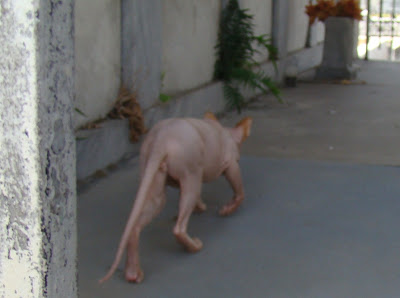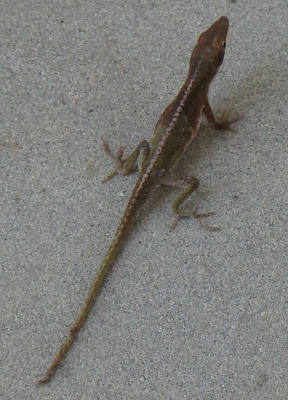 Early settlers first tried to stop coffins from rising and floating by drilling in holes, or filling and covering them with rocks.
Early settlers first tried to stop coffins from rising and floating by drilling in holes, or filling and covering them with rocks.  First we went to Metairie Cemetery where I was drawn to the Brunswig family Egyptian tomb.
First we went to Metairie Cemetery where I was drawn to the Brunswig family Egyptian tomb. Hellooooo? Anyone home?
Hellooooo? Anyone home? Drats. It is locked. Not much hope of an interview here.
Drats. It is locked. Not much hope of an interview here. Put me down Daddy, I need to investigate.
Put me down Daddy, I need to investigate. Well this Sphinx outside certainly shows they have some style!
Well this Sphinx outside certainly shows they have some style!  However, I think I am the more handsome of the two.
However, I think I am the more handsome of the two.  Does this make my feet look big?
Does this make my feet look big? Ooh! What is over there?
Ooh! What is over there? Metairie Cemetery began as a racetrack in 1838, but became damaged in the civil war and was converted into this final resting place in 1872. The outline of the racing course is still visible in the placement of the graves.
Metairie Cemetery began as a racetrack in 1838, but became damaged in the civil war and was converted into this final resting place in 1872. The outline of the racing course is still visible in the placement of the graves.  Metairie is known for its magnificent monuments, and was listed by Forbes as one of the top 10 best burial grounds. Louis Prima is among the affluent deceased resting here!
Metairie is known for its magnificent monuments, and was listed by Forbes as one of the top 10 best burial grounds. Louis Prima is among the affluent deceased resting here! I like to enjoy all the small details in the stone work.
I like to enjoy all the small details in the stone work. The tree trunk to the left is a funerary symbol for a short life.
The tree trunk to the left is a funerary symbol for a short life. This mausoleum with a large standing angel is very interesting! I wonder what she is looking at?
This mausoleum with a large standing angel is very interesting! I wonder what she is looking at? Hmm. You can see a lot from up here!
Hmm. You can see a lot from up here! Hey is that a Green Anole?
Hey is that a Green Anole? Gotcha! I I told mom I was trying to help him find his family plot but she made me spit him out! She ruins everything.
Gotcha! I I told mom I was trying to help him find his family plot but she made me spit him out! She ruins everything.  So much for my little snack.....er good Samaritan deed.... it tasted sour anyway.
So much for my little snack.....er good Samaritan deed.... it tasted sour anyway. Green Anoles are arboreal lizards native to the southeastern US, Texas and Louisiana. They have special toes that enable them to climb smooth vertical surfaces.
Green Anoles are arboreal lizards native to the southeastern US, Texas and Louisiana. They have special toes that enable them to climb smooth vertical surfaces. As we drive away I watch out for more lizards.
As we drive away I watch out for more lizards. Then I decide to look at something more beautiful....my reflection!
Then I decide to look at something more beautiful....my reflection! Next we do some strollering in St. Louis Cemetery #3.
Next we do some strollering in St. Louis Cemetery #3. You may notice my black leather harness has "skull" studs.
You may notice my black leather harness has "skull" studs. St. Louis Cemetery #3 was created in 1854 and was originally named the Bayou Cemetery, because of its proximity to Bayou St.John. Before that, the land was used as a Leper Colony!
St. Louis Cemetery #3 was created in 1854 and was originally named the Bayou Cemetery, because of its proximity to Bayou St.John. Before that, the land was used as a Leper Colony! After the great Yellow Fever outbreak in 1853 though, the city needed another graveyard more than it needed a Leper Colony, so the land was diversified.
After the great Yellow Fever outbreak in 1853 though, the city needed another graveyard more than it needed a Leper Colony, so the land was diversified. Sniff, sniff. Smells like granite!
Sniff, sniff. Smells like granite!  This cemetery is in great condition, and is still a popular resting place. In fact there is a waiting list to be buried here.
This cemetery is in great condition, and is still a popular resting place. In fact there is a waiting list to be buried here. I was very impressed with the Iron work here. These are likely cast iron which became popular in America in the 1850's due to increased availability of zinc. Before that wrought iron was used in older New Orleans cemeteries.
I was very impressed with the Iron work here. These are likely cast iron which became popular in America in the 1850's due to increased availability of zinc. Before that wrought iron was used in older New Orleans cemeteries. So there you have it, the cemeteries in NOLA are beautiful, historic and even have snacks! Additionally, I highly recommend strollering to cover such large grounds. Metairie, and St.Louis #3 graveyards have my 5 meows out of 5.Do not forget to check out ALL my other blog reviews! Just choose a date under the "More of my Adventures" heading in the upper right column.
So there you have it, the cemeteries in NOLA are beautiful, historic and even have snacks! Additionally, I highly recommend strollering to cover such large grounds. Metairie, and St.Louis #3 graveyards have my 5 meows out of 5.Do not forget to check out ALL my other blog reviews! Just choose a date under the "More of my Adventures" heading in the upper right column.
© 2011 Aislynne












